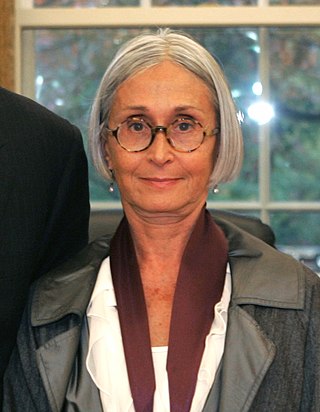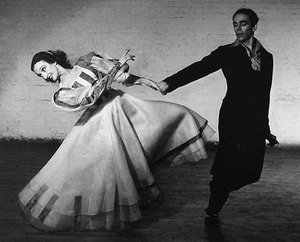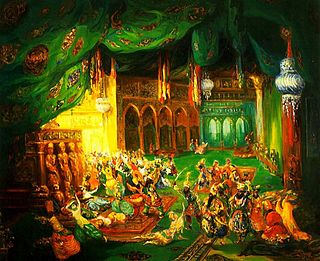
Twyla Tharp is an American dancer, choreographer, and author who lives and works in New York City. In 1966 she formed the company Twyla Tharp Dance. Her work often uses classical music, jazz, and contemporary pop music.

Ruth Crawford Seeger was an American composer and folk music specialist. Her music was a prominent exponent of the emerging modernist aesthetic and she became a central member of a group of American composers known as the "ultramoderns". Though she composed primarily during the 1920s and 1930s, Seeger turned towards studies on folk music from the late 1930s until her death. Her music influenced later composers, particularly Elliott Carter.

William Grant Still Jr. was an American composer of nearly two hundred works, including five symphonies, four ballets, nine operas, over thirty choral works, art songs, chamber music, and solo works. Born in Mississippi and growing up in Little Rock, Arkansas, Still attended Wilberforce University and Oberlin Conservatory of Music as a student of George Whitefield Chadwick and then Edgard Varèse. Because of his close association and collaboration with prominent African-American literary and cultural figures, Still is considered to be part of the Harlem Renaissance.

"The Saint Louis Blues" is a popular American song composed by W. C. Handy in the blues style and published in September 1914. It was one of the first blues songs to succeed as a pop song and remains a fundamental part of jazz musicians' repertoire. Benny Goodman, Louis Armstrong, Cab Calloway, Bing Crosby, Bessie Smith, Eartha Kitt, Count Basie, Glenn Miller, Guy Lombardo, Peanuts Hucko, and the Boston Pops Orchestra are among the artists who have recorded it. The song has been called "the jazzman's Hamlet". Composer William Grant Still arranged a version of the song in 1916 while working with Handy.

Doris Batcheller Humphrey was an American dancer and choreographer of the early twentieth century. Along with her contemporaries Martha Graham and Katherine Dunham, Humphrey was one of the second generation modern dance pioneers who followed their forerunners – including Isadora Duncan, Ruth St. Denis, and Ted Shawn – in exploring the use of breath and developing techniques still taught today. As many of her works were annotated, Humphrey continues to be taught, studied and performed.

Scheherazade, also commonly Sheherazade, Op. 35, is a symphonic suite composed by Nikolai Rimsky-Korsakov in 1888 and based on One Thousand and One Nights.

Symphonic Dances, Op. 45, is an orchestral suite in three movements completed in October 1940 by Russian composer Sergei Rachmaninoff. It is his final major composition, and his only piece written in its entirety while living in the United States.

Ballet is a formalized form of dance with its origins in the Italian Renaissance courts of 15th and 16th centuries. Ballet spread from Italy to France with the help of Catherine de' Medici, where ballet developed even further under her aristocratic influence. An early example of Catherine's development of ballet is through 'Le Paradis d' Amour', a piece of work presented at the wedding of her daughter Marguerite de Valois to Henry of Navarre. Aristocratic money was responsible for the initial stages of development in 'court ballet', as it was royal money that dictated the ideas, literature and music used in ballets that were created to primarily entertain the aristocrats of the time. The first formal 'court ballet' ever recognized was staged in 1573, 'Ballet des Polonais'. In true form of royal entertainment, 'Ballet des Polonais' was commissioned by Catherine de' Medici to honor the Polish ambassadors who were visiting Paris upon the accession of Henry of Anjou to the throne of Poland. In 1581, Catherine de' Medici commissioned another court ballet, Ballet Comique de la Reine, however it was her compatriot, Balthasar de Beaujoyeulx, who organized the ballet. Catherine de' Medici and Balthasar de Beaujoyeulx were responsible for presenting the first court ballet ever to apply the principles of Baif's Academie, by integrating poetry, dance, music and set design to convey a unified dramatic storyline. Moreover, the early organization and development of 'court ballet' was funded by, influenced by and produced by the aristocrats of the time, fulfilling both their personal entertainment and political propaganda needs.

Modern dance is a broad genre of western concert or theatrical dance which includes dance styles such as ballet, folk, ethnic, religious, and social dancing; and primarily arose out of Europe and the United States in the late 19th and early 20th centuries. It was considered to have been developed as a rejection of, or rebellion against, classical ballet, and also a way to express social concerns like socioeconomic and cultural factors.
Chicago Opera Ballet was a Chicago dance company located in downtown Chicago.
Águas da Amazônia, Sete ou oito peças para um balé is a 1993–99 musical composition by the American contemporary classical composer Philip Glass. Its first recording was performed by the Brazilian instrumental group Uakti.

Miss Sally's Party is a 1940 ballet composition in eight-movements by American composer William Grant Still. A related libretto was written by Verna Arvey, wife of composer Still. The ballet was first performed on May 2, 1941, and is about nineteen minutes long.

Lenox Avenue is a series of ten orchestral episodes and a finale composed in 1937 by American composer William Grant Still. The composition is for orchestra, chorus and announcer; the narration was written by Verna Arvey, wife of composer Still. The first performance was broadcast nationally on radio on May 23, 1937, conducted by Howard Barlow. A related ballet version was composed in 1938, and is about twenty-one minutes long.

Symphony No. 2 in G minor, also known as Symphony No. 2"Song of a New Race", is a 1937 composition in four movements by American composer William Grant Still. The work was first performed on December 10, 1937, by the Philadelphia Orchestra led by conductor Leopold Stokowski. The symphony is about thirty minutes long.

Sahdji is a 1930 ballet composition in two-movements by American composer William Grant Still. The ballet was first performed in 1931 under the direction of Howard Hanson at the Eastman School of Music. The work is about twenty minutes long.

Africa is a 1930 symphonic poem in three movements by American composer William Grant Still. The work, originally scored for chamber orchestra, was first performed in 1930 by French flautist Georges Barrère and, in a full orchestra version, by Howard Hanson on October 24, 1930, at the Eastman School of Music in Rochester, New York. The work is about twenty-eight minutes long.

Darker America is a 1924 symphonic poem by American composer William Grant Still. The composition, exploring themes of sorrow, hope, and prayer, is a work derived from Still's studies with the modernist composer Edgard Varèse. In the work, Still uses "melodic types found in African American music such as the descending melodic curve, the pentatonic scale of the spirituals, and the 'blues scales' of the blues. The primary harmonies used were the tonic, subdominant, and dominant harmony of the spirituals." The work was first performed by Eugene Goossens on November 22, 1926 at the Aeolian Hall in New York City, New York and is about twelve minutes long.

Three Visions is a 1935 suite in three parts for solo piano, and later, the second part, Summerland, for chamber orchestra, by American composer William Grant Still. According to Judith Anne Still, the composer's daughter, "The three segments of the suite, Dark Horsemen, Summerland, and Radiant Pinnacle, tell the story of the human soul after death: the body expires, and the soul goes on to an apocalyptic judgment. If it is seen that the past life has been a good one, the soul may enter “heaven,” or “Summerland”. After a period of time, the soul may reincarnate to learn additional earthly lessons on the human plane. Some souls reincarnate many times in a constant circular progress toward Godly perfection." Three Visions was composed by Still for his wife, Verna Arvey, who first played the composition in Los Angeles in 1936. The suite is about eleven minutes long.

Blue Steel is a 1934 opera by American composer William Grant Still. Overall, the music assumes a jazz form, harmonically and rhythmically, although at other times, the music merges into the form of a Negro spiritual.

Kaintuck' (Kentucky) is a 1935 symphonic poem for piano and orchestra by American composer William Grant Still.









